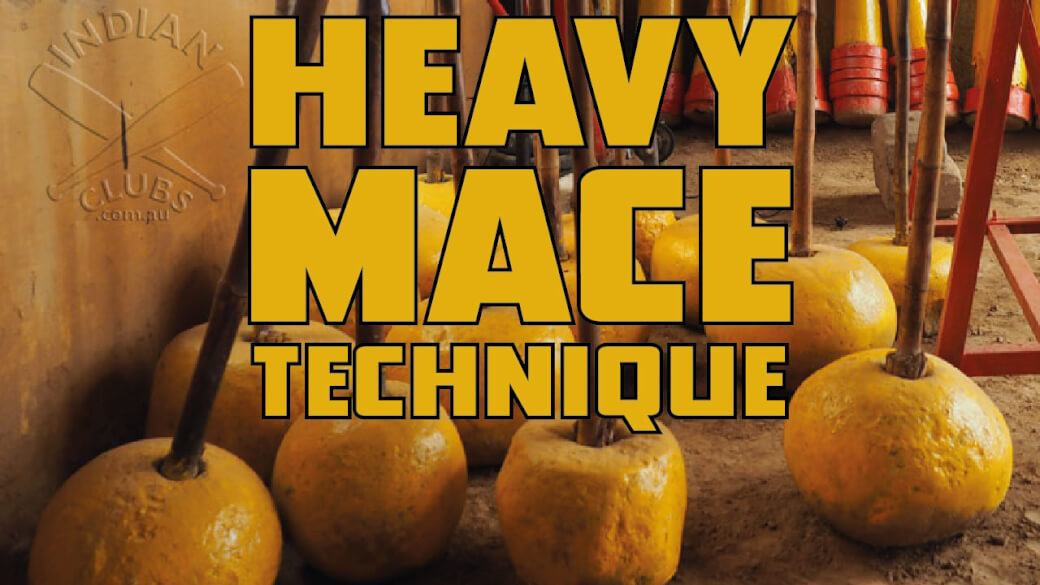Heavy Mace Technique
Before we get into the nitty-gritty of the Heavy Mace Technique here is some background information about the Mace (gada).
Clumsy and Unbalanced
You have to bear in mind that a Mace (Gada) is clumsy, unbalanced and intended to be difficult to handle. It provides swinging movements as the weight on the end generates centrifugal force as the mace is swung around the body.
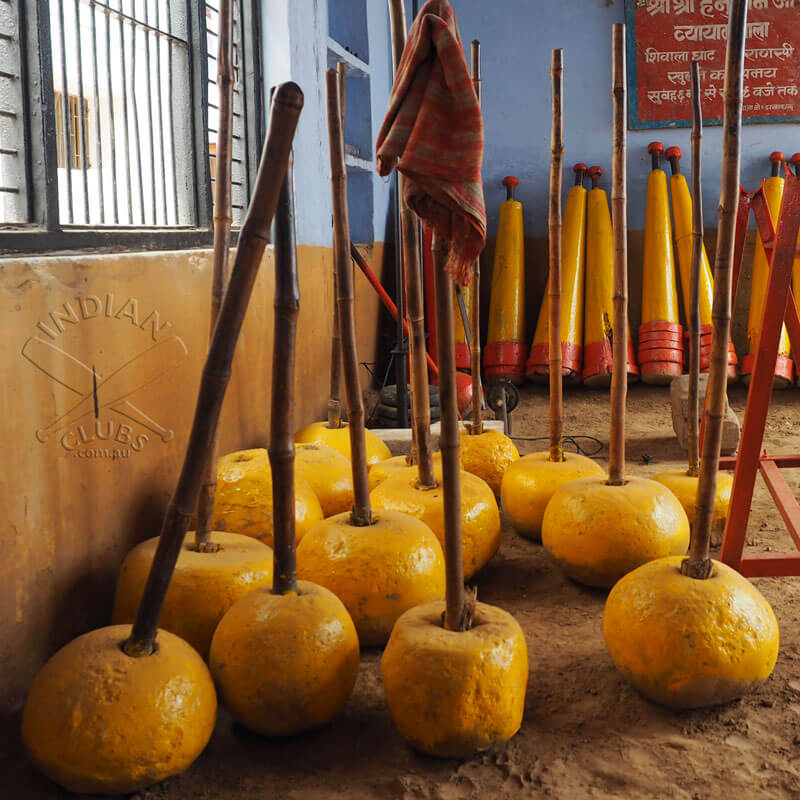 Three Disciplines – Traditional Heavy Mace
Three Disciplines – Traditional Heavy Mace
1Shoulder Contact Rotate and Swing Method
Heavier weights are used in Mace (gada) competitions which are held annually in early August during the Cobra Festival (Nag Panchami). The weights reach mind-bending loads of 30kg, 40kg, 50kg, 60kg and higher.
2Traditional Mace (gada) No Contact Swing Method
The Mace (gada) is swung for exercise, suppleness and agility, benefitting the shoulders, arms, grip and core. It is a part of day-to-day, year-round training in an Akhara (wrestlers gym). The Gada (mace) is often swung in a ladder format, starting at 10kg, 15kg, 20kg up to 25kg, using the 10-2 swing format.
3Mace Flow – Manipulation, Dance, Yoga and Drum Major
Mace Flow is a recent western invention that is often referred to as low impact cardio, yet claims that you will train like a warrior. The method disregards the unbalanced properties of the Mace by changing the weight distribution in handling, mainly by gripping the handle close to the head of the mace.
The effect of changing Mace weight distribution
Changing the weight distribution of a mace, during exercise avoids most if not all of the swinging and rotational benefits that traditional exercises like the 360 and 10-2 swings have to offer. The mace used for Mace Flow is generally lightweight and should be renamed ‘Baton’ due to its lightweight and manoeuvrability.
In India the goal of Mace (gada) swing is not used for manipulation, dance, yoga, it is only used for daily training, competition and wrestling.
Make your own Traditional Mace
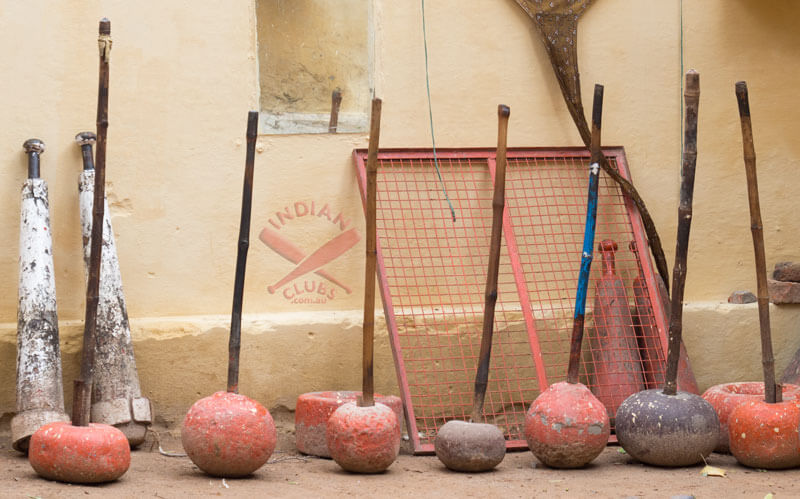
Heavy Mace Technique
In this article, we will look at the technique and methods used in swinging a Heavy Mace (gada) which has been written by Joohyun Kim from the House of Strength and Soma and Body, Korea.
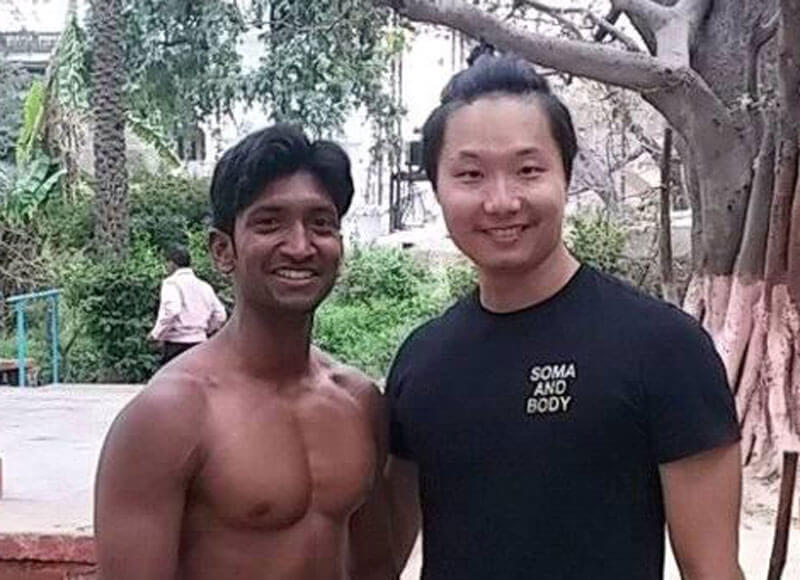
Quotes
Pratyay Singh: “It is very tough and dangerous to swing a heavy Mace (gada) without resting the handle on the shoulder.”
Joohyun Kim: “The technique of resting the Mace (gada) handle on the shoulder is complex and builds on the non-contact Mace (gada) swing method.”
Heavy Mace Technique 48kg
Why do the Kushti wrestlers swing a Mace (gada)?
Joohyun Kim: The intention of the Mace (gada) swing is to wrestle better. The most interesting fact, when I went to India, was that the Hindi verbs ‘ घुमाना (goomana)’ or ‘चक्कर देना (jeggudina)’ used in the Mace (gada) swing means “rotate”.It also means throwing an opponent in traditional wrestling. Indian wrestlers train with the Mace (gada) with the intention of throwing their opponent better.
Throwing Better
Joohyun Kim: When wrestling, an arm throw motion requires that the anterior area of the player who is attempting a throw, should stay close to the posterior area of the opponent. (Those who have done it will agree.)
Head and Arm Throw Definition
Throws are very common freestyle moves from the neutral position. The head and arm throw is an effective move that can set up extra points and pinning combinations. To do the move, use one hand to grab your opponent’s triceps while your other arm crosses behind your opponent’s head, resting on his or her neck and meeting your other hand on the triceps. Step into your opponent with your outside leg and twist toward him or her by 180 degrees. Pop your hips upward and twist his or her upper body down toward the mat.
Mimic an Arm Throw
Joohyun Kim: In order to train and mimic an Arm Throw with the Mace, the handle must lean against the shoulder and stay close to the body, this method can be transferred and applied to wrestling.
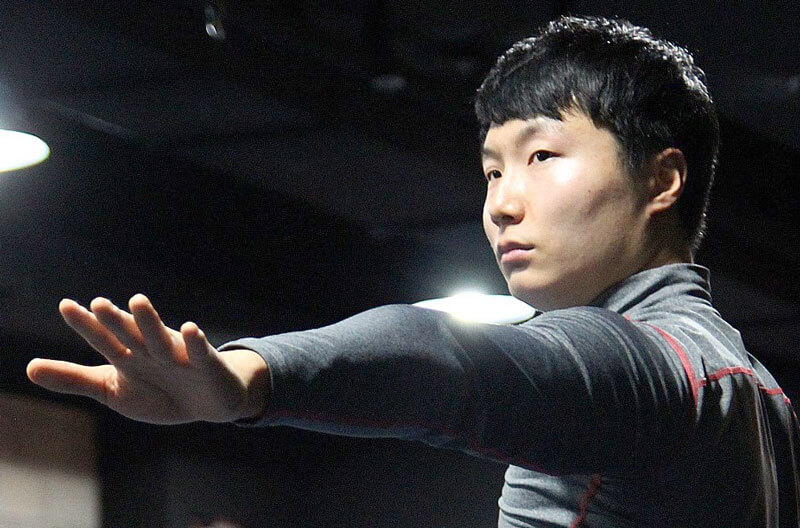
Cheating
Joohyun Kim: Some people think that you are cheating if the Mace handle leans on the shoulder, which is simply wrong. It is like saying that at the Olympic barbell lifting competition, the barbell should not touch the shin or thigh. There is no cheating in lifting. This is not bodybuilding.
Maximum Efficiency
Joohyun Kim: The purpose of lifting is to lift more weights and more repetitions. It requires maximum efficiency. Therefore, when lifting, the weight should be as close as possible to the centre of gravity of the body. In the Mace (gada) swing, resting the handle on the shoulder is the best way. This applies equally to wrestling and martial arts. It is a super skill to overcome a stronger, bigger opponent with less power, smarter movement.
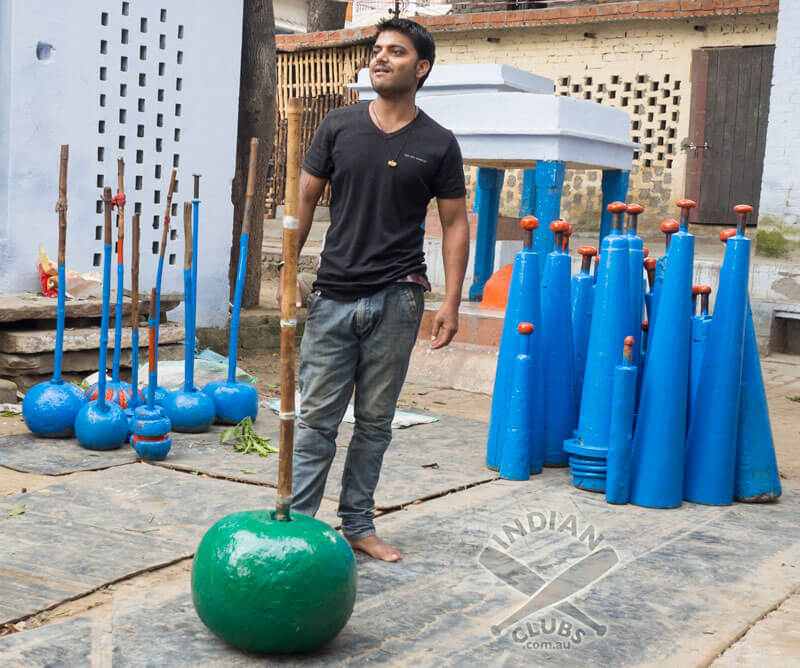
Sophisticated Movement
Joohyun Kim: Therefore, the technique of the handle leaning on the shoulder is an advanced technique. It uses the science of a very sophisticated movement and not specific muscle strength. An Indian wrestler can use this technique to swing his Mace (gada) as heavy as his own body weight. It means that he can throw his opponent as heavy as he with his pure skill.
Looks Easier
Joohyun Kim: Resting the Mace (gada) handle on the shoulder looks easier, but the technique is much more difficult to learn. Simply because it is not all about the shoulder rest as this is only a small part of the overall technique visible to the eye.
An Incredible Effort
Joohyun Kim: The details of the technique with the Heavy Mace Technique are complex. The Pahlavan swinging the Heavy Mace (gada) in this video has developed his technique which in reality is his life work. Nobody can say that he has the wrong technique.
Heavy Mace Technique Explanation
Five Years to Understand
Joohyun Kim: In my case, it took me five years to understand and actualise the movement science of lifting and swinging a Heavy Mace (gada). It is 100 times harder than dancing with a lightweight mace bell.
The Non-Contact Mace Technique has Limitations
Joohyun Kim: The non-contact Mace technique that does not rest the handle on the shoulder has the advantage of being able to put more weight on the shoulder girdle. But there is a limit to increasing weight and repeatability.
Lever Protection
Joohyun Kim: Claiming that leaning the handle on the shoulder makes it easier to reduce the length of the handle levers, it is half right and half wrong.
Levering the handle on your shoulder protects you
Different Tools
Joohyun Kim: It is better to think of Lightweight Mace (under 30kg) and the Heavy Mace (over 30kg) as different tools.
Consider Different Strategies
Joohyun Kim: You can swing a pair of 2lb Indian Clubs in a complex routine with maximum arm extensions overhead and out to the sides because your joints, ligaments and tendons are capable of withstanding these weights. The question is, can you do the same big movements with a 30lb Steel Club?
Even if they are similar in shape, their weights are different, you should make different strategies as they are different tools.
The Big Pahlavan Secret
Joohyun Kim: I found the big secret of the heavy gada lifter’s Mace swing. The secret is using your head like a pendulum swing and coordinating the movement between your shoulder and your head.
Will your Back Break?
Joohyun Kim: To people who claim that resting a Mace handle on the shoulder is wrong, I recommend they try to swing a 60kg Mace (gada). Do you think your shoulders will hurt when the Mace (gada) swings behind your back? No. The lower back will be broken first.
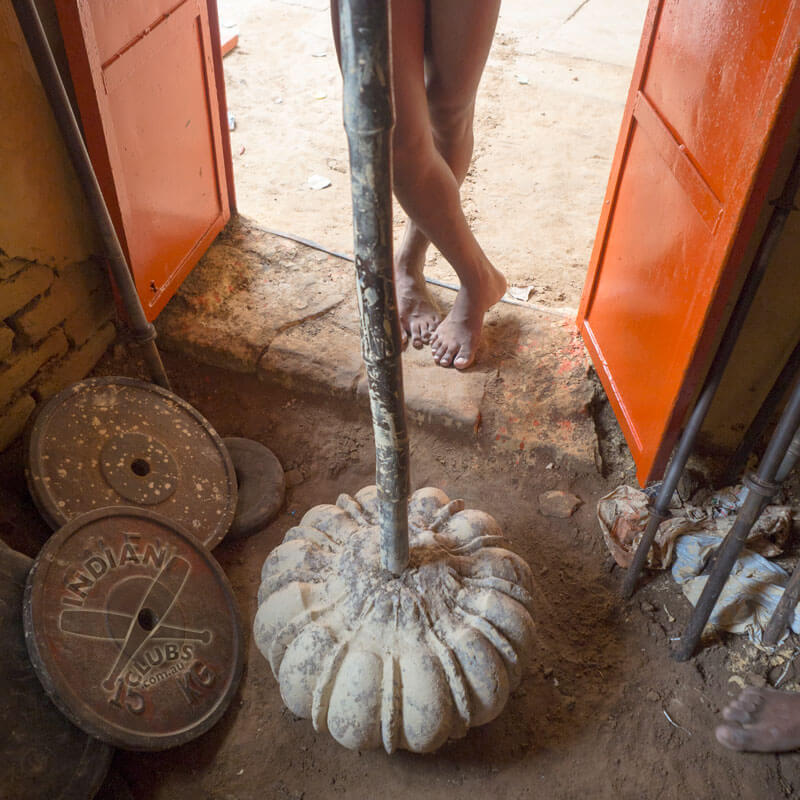
The Weight Quadruples – Heavy Mace Technique
Joohyun Kim: As the Mace (gada) is swung behind the athlete. Gravitational pull quadruples the original weight. 60kg becomes 240kg.
Can you handle 240kg swinging up onto your shoulder?
Heavy Mace Technique 40kg
Hips Folded and the Body Slightly Bent Forward
Joohyun Kim: The correct heavy technique dictates that the Mace (gada) head should be sent as far as possible to the side with the hips folded and the body slightly bent forward. In these circumstances, the handle has to rest on the shoulder.
The Spine and Handle must work in unison and remain Parallel
Joohyun Kim: Also as the Mace (gada) falls to the back and rises on the opposite side, the spine and handle must work in unison and remain parallel. To maintain the parallel in the pendulum section, it is necessary to rest the handle to the shoulder and launch the head firmly to the side achieving extreme counterbalance. If the spine and handle misalign and the parallel breaks, the torque of 240 kg is put on the shoulders and elbows.
It takes considerable study, observation and a lot of practice to master the Heavy Mace Technique and make it a reality.
I would like to extend huge thanks to Joohyun Kim for contributing this information about the Heavy Mace Technique
KOREAN TRANSLATION
최근 60kg 고중량 메이스벨 영상을 놓고 페이스북 상에서 핸들을 어깨에 터치를 하는 행위에 대한 갑론을 박이 있었다.
여기에 대한 본인의 의견을 피력하자면, 어깨에 기대고 하는 테크닉이 터치없이 하는 것보다 훨씬 하이 퀄리티 테크닉이다.
우리는 Kushti 레슬러들이 왜 메이스벨 스윙을 하는지 주목해야한다. 그들이 메이스벨을 다룰 때의 의도는 상대를 더 잘 업어치기 위해서이다.
필자가 2015년 인도에 갔을 때 가장 흥미로웠던 사실 중 한가지는, 인도 레슬러들이 메이스벨(गदा Gada)을 돌린다고 말할때 사용하는 동사가 ‘돌리다’, ‘거칠게 던지다’의 뜻을 가진 घुमाना(goomana) 혹은 चक्कर देना(jeggudina) 였는데 이 용어는 전통 레슬링에서 상대를 넘겨 던진다라는 뜻으로도 동시에 사용된다는 것이었다. 인도 레슬러들은 이미 상대를 던진다라는 명확한 의도를 메이스벨에 투영해 훈련해 왔던 것이다.
실제로 레슬링에서 업어치기할때 가장 중요한 것은 상대방의 몸과 내 등을 밀착하는 것이다. (업어치기를 해본 사람들은 공감할 것이다.)
메이스벨 또한 어깨에 기대서 몸에 밀착을 해야만 레슬링에서와 같은 감각으로 운동할 수 있으며 비로소 레슬링의 업어치기에 전이 할 수 있다.
국내에서는 메이스벨 유저가 흔하지 않지만 해외에서는 생각보다 활성화 되고 있는 추세이다.
그 와중에 간혹 핸들을 어깨에 기대는 것을 마치 치팅으로 여기는 사람들이 있는데, 이것은 아주 멍청한 의견이다. 마치 올림픽 바벨리프팅 시에 바벨이 정강이나 허벅지, 몸통에 닿으면 안된다고 말하는 것과 같다.
리프팅에 치팅은 없다.
리프팅의 목적은 더 무거운 무게를 더 많이 드는 것이다. 최대의 힘을 요구하는 동시에 최대의 효율을 요구한다. 내가 가진 온갖 힘을 다 쏟아부어 어떻게든 들어올려야하고 이 과정에서 최대효율을 낼 수 있는 전략을 어떻게든 발휘해야만 한다. 이러한 전제를 두고 생각해 보았을때 리프팅하는 물체가 내 몸의 무게 중심과 최대한 밀착해서 역학적 이득을 취해야 더 무거운 중량을 들 수 있다는 것은 어린 아이도 알만한 당연한 사실이다.
이 사실은 레슬링과 무술에서도 똑같이 적용된다. 더 적은 힘으로 더 강하고 큰 상대를 제압하는 것이 바로 기술이다.
그러므로 메이스벨 핸들을 어깨에 기대는 테크닉은 터치 하지 않는 테크닉에 비해서 훨씬 하이 퀄리티 테크닉이다.
이 테크닉은 단순한 극육의 힘이 아닌 아주 정교한 움직임의 과학을 사용한다. 인도 레슬러가 이 하이테크닉을 사용해 자신의 몸무게 만큼 무거운 메이스벨을 스윙 할 수 있다는 것은 비로소 해당 움직임 패턴이 최적화되어 자신만큼 무거운 상대를 마치 메이스벨 스윙 하듯이 던져버릴 수 있다는 것을 의미한다.
간혹 의아하게 생각하는 사람도 있을 것이다.
핸들을 어깨에 기대는 것이 겉으로 보기엔 더 쉬워보이지만 습득하기에는 훨씬 어려운 테크닉이다.
단순히 핸들을 어깨에 기대는 것이 전부가 아니기 때문이다. 전체적인 테크닉 중에 눈으로 보여지는 극히 일부일 뿐이다.
인도의 헤비 메이스벨 리프터들의 영상에서 디테일한 테크닉들은 하루아침에 되는게 아니다. 필자는 헤비 메이스벨 리프터의 머리의 움직임을 이해하고 실제 구현하는데에만 무려 5년이 걸렸다. 아기들이나 다룰 법한 무게의 메이스벨로 춤이나 추는 짓거리보다 100배는 어렵다.
어깨에 기대지 않은 테크닉은 더 많은 무게를 견갑대에 실을 수 있다는 장점이 있다. 하지만 이러한 노 터치 테크닉은 무게에도 반복수에도 어깨 관절과 인대가 버티는 데에 한계가 있을 수 밖에 없다.
핸들을 어깨에 기대는 것이 핸들 지렛대의 길이를 줄여서 더 쉽게 만든다라고 주장한다면 그것은 반은 맞고 반은 틀리다.
핸들을 어깨에 기대는 것은 당신을 보호하기 위함이다.
일반 메이스벨과 40kg 이상의 고중량 메이스벨은 서로 다른 도구라고 생각하는 것이 낫다.
상상해보라. 2파운드 나무 인디언클럽으로는 내 몸과 최대한 멀어지게 빅 스윙과 화려한 콤비네이션을 해도 내 관절과 인대가 충분히 버틸만하기 때문에 괜찮다. 하지만 과연 30파운드 스틸 인디언클럽으로 똑같이 할 수 있을까? 모양이 비슷해도 무게가 달라지면 다른 도구라고 생각하고 다른 전략을 취해야한다.
아직까지도 메이스벨을 어깨에 기대면 안된다고 주장하는 사람들이 있다면 메이스벨 60kg을 등 뒤로 넘겨서 스윙을 시도해봐라.
어깨를 다칠 것 같나? 아니다. 허리가 부숴진다.
메이스벨이 등뒤로 떨어지면 원래 가진 무게의 4배정도의 토크가 걸린다.
과연 당신이 240kg의 무게를 견디면서 안정화를 유지할 수 있을까?
살기 위해서 머리는 최대한 앞으로 보내야한다. 그래서 고관절이 접히고 약간 앞으로 숙여지게된다. 그 과정에서 핸들이 어깨에 기대지는 것이다. 살기위해.
또한 메이스벨이 등뒤로 떨어지고 다시 떠오르는 구간까지 척추와 핸들의 평행이 유지되면서 움직여야한다. 이 평행이 깨지는 순간 240kg의 토크가 어깨와 팔꿈치에만 실려버린다.
펜듈럼 구간에서 이 평행을 유지하기위해 핸들을 어깨에 붙이고 머리를 한쪽으로 강하게 던져주는 것이 필수다. 그리고 이 테크닉을 습득하고 이 감각을 깨닫기 까지는 상당한 관찰력과 시간을 필요로 한다.
어깨를 터치 하지 않는 테크닉을 깍아내리려는 의도는 전혀 없으니 오해는 마시라.
메이스벨의 구조와 무게의 증가에 따른 한계와 그에 따른 테크닉과 전략의 변화에 대해 유연하고 진지하게 생각해보고자 할 뿐이다.
